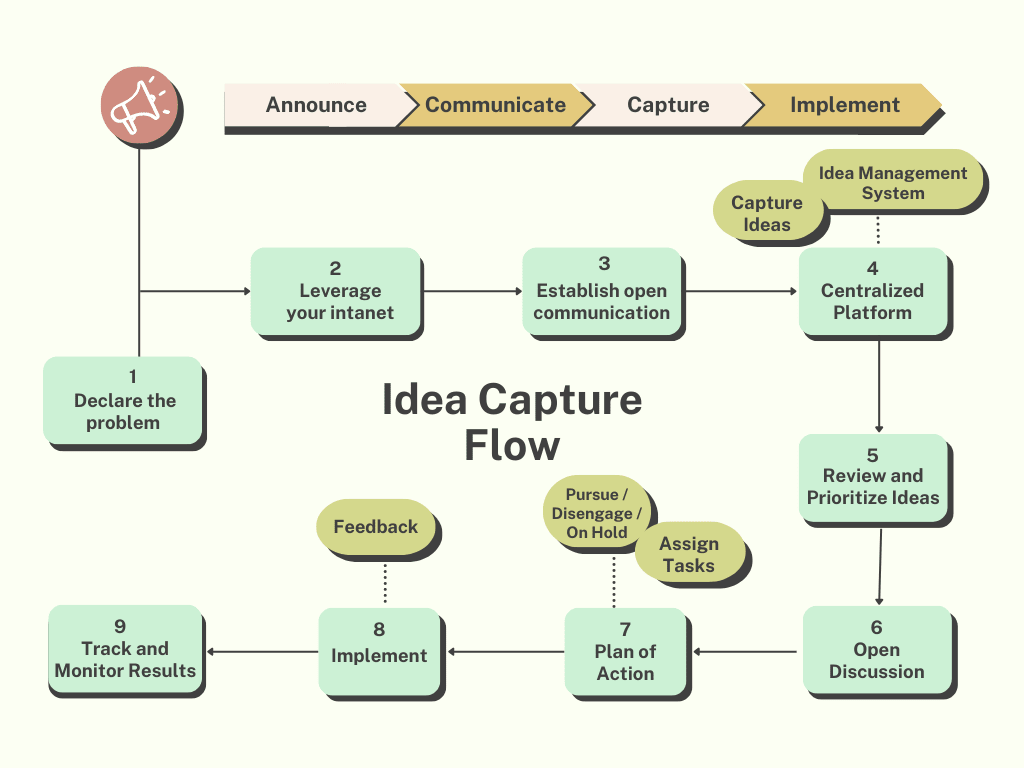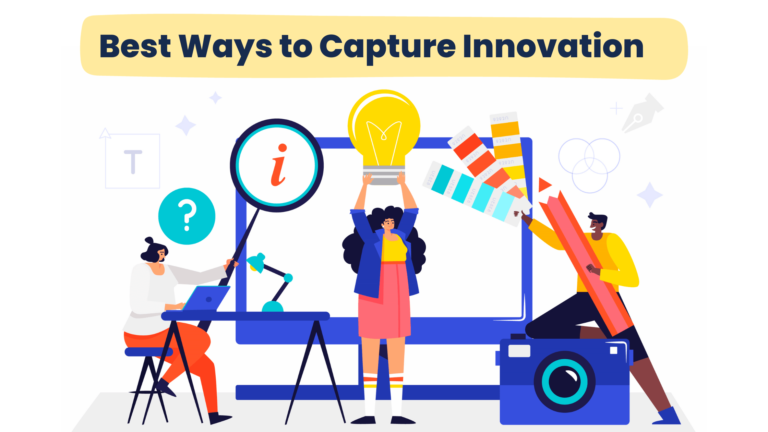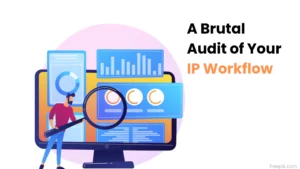When we ask anyone from the C-suite or a business leader what is their key priority for their company? The majority of them state that it is to capture innovation and creative new ideas.
But as a part of their latest research—State of Organizations 2023, McKinsey & Company surveyed more than 2500 business leaders around the world and found a contradictory result.
Half of the 2500 leaders said their organizations aren’t well prepared to anticipate and react to
- external shocks, such as the COVID-19 pandemic,
- the ensuing economic slowdown,
- soaring inflation,
- geopolitical disruption.
Basically, even though leaders stated corporate innovation as their priority, they feel unprepared for the constantly evolving competitive landscape and market.
This is why various studies suggest that the lifespan of even the biggest 500 companies is decreasing significantly.
So, when they know the problem statement and the solution, where is the gap?
Execution! Everything boils down to idea capture and innovation capture.
They are aware of what they need to do but not how to exactly do it.
This is why the most asked question remains: “How can I find help with innovation for my business?”
So let’s review how!
Start capturing innovation with InspireIP – Access a 30-day free trial in under 3 minutes.
How to capture innovation?
You can reorient your organization as long as you realize that capturing innovation is not just about ideas, it’s about people.
When you equip people around you with the right tools and environment, they drive change.
True innovation is about telling people that it is perfectly okay to try something new as many times as they want and can.
On that note, let’s learn what triggers innovation and innovation capture.
#1 Introduce a Centralized Platform
Did you know that the Nordic countries are at the top of the innovation scale every year?
Studies prove it’s because they are culturally open and embrace diversity, two important factors in the successful development of innovative minds.
You must understand that when your organization discards the idea of titles and emphasizes flourishing each and every member equally, you facilitate generating ideas.
Anyone, literally, anyone in your organization can be the person to come up with an invention–big and small. And you need to capture it!
Related Read: How Frito Lay Cheetos were an innovation by a janitor?
So you need to establish a centralized platform through strategic planning, goal setting, budgeting, and talent deployment that will collect ideas flowing across verticals.
This centralized platform can be as simple as a company email address with either all the members or only the decision-makers added to the list.
Or, it can be a team of professionals especially trained and deployed for the idea management task in your organization.
But you’ll soon need an automated central system or tool to replace individual teams and chunky systems.
That’s because our end goal is scalability. It is to grow by sorting incoming ideas swiftly and implementing them for quick time-to-value.
Anyway, your role remains key: Introducing a centered medium for one and all.
So now when marketing folks come up with a new product idea, you can capture it, review it, and implement it.
That’s innovation!
You’ve got yourself people who see possibilities and not obstacles and a medium that implements it.
Try InspireIP for free, for 30 days!
#2 Recognize, Acknowledge, and Support
Now what if the marketing team that came up with the product idea fails to implement it successfully?
What would be the popular reaction? Whispers and jabs from colleagues across verticals and maybe sympathy too.
But your reaction towards their effort and your gratefulness towards their quest for innovation and improvement must be loud and clear.
And when it’s a janitor with an idea to replace plastic straws with sustainable ones, you must be the first to support and capture the idea.
How will you capture the ideas?
To capture ideas, you may revert to the old methods getting overlooked in the modern and digital office landscape:
- Open Communication: A flat hierarchy and approachable management to establish trust and camaraderie.
- Focus Groups: Multiple groups designed to brainstorm and investigate new solutions or find inventions through collaboration with people of similar interests.
- Staff Meetings: Informal meetings with your staff. Note that you must enable employees to schedule these meetings as well as per requirements.
- Kaizen Corner: A physical or virtual space where employees can go to share their ideas freely.
When you, the upper management, show employees that you recognize, value, and support their opinions and presence, they care for your product and establishment.
Employees must enjoy these old-school methods to capture innovation so they contribute well.
Employee innovation benefits must be loud and clear.
#3 Integrate an Idea Management Tool to Capture Innovation
Large organizations face numerous challenges, such as:
- Intrinsic aversion to change.
- Multiple bases across the globe.
- Diverse existing product and service offerings.
- Humongous workforce.
- Time constraints.
- Orthodox view to unsuccessful ventures.
The good news is: You can easily integrate idea management software with your existing intranet or introduce it to your internal ecosystem.
The best part is that a professional ideation software focused on innovation in the workplace pre-integrates the best practices mentioned above.
For example: open communication, focus groups, staff meetings, and kaizen corner.
When you take a bottom-top approach to capturing ideas and open communication through a professional tool, you successfully:
- Embrace innovation from people of different verticals, genres, personality traits, ideas, and whatnot!
- Invest time in creative thoughts.
- Accelerate the company’s digitization process at the grassroots level.
- Employ crowdsourcing techniques to encourage a large number of participants.
Related Read: Learn how to get the most out of innovative ideas.
When you invest in people, their ideas, and their betterment, you lay the foundation for a long-lasting relationship, which brings us to your next task.
#4 Build and Nurture Relationships
What if we focused less on the innovation capture and more on the steps we can take to build workplace innovation, such as :
- Let’s not overwhelm anyone and make generating ideas a chore.
- Explain the importance of generating ideas and striking a balance between creativity and technical tasks.
- Touch base on the importance of contribution.
- Illustrate how an idea can lead to invention.
- Educate employees on how to engage with the idea management tool.
- Take constant feedback and improve on idea capture processes as you receive the feedback.
- Elaborate on how folks can ask for help and do not have to compete with anyone.
More often, the answer to executing a plan comes from internal inspection. When you listen to them, your team will let you know what they need and how.
Related Read: How to build an effective corporate innovation strategy?
#5 Implement Successful Employee Innovation Programs
Too often, organizations choose to announce employee suggestion programs periodically. Although it’s not that these programs don’t work, we have a tested permanent solution.
Instead of periodic idea capture methods, put in place an everlasting program that enables employees to benefit from generating ideas on every business day.
But to run a successful employee idea program, you need to:
- Create an end-to-end plan of action, including roadmaps, timelines, budgets, and feedback mechanisms.
- Set up a dedicated team to oversee the ideas splurging through your idea management tool.
- Ensure everyone participates in the process. From upper management to newly hired temps, everyone must be treated equally throughout the entire idea capture process.
- Ensure the program is sustainable. It should be able to keep up with emerging challenges, such as the increasing number of employees, internal challenges, exertion issues, setting KRAs, and so on.
#6 Put out the Problem Statement
Let the problem statement be known as clearly as possible.
Leverage your intranet to discuss the action items. If the challenges are out in the open, everyone can contribute profusely.
Research shows that when employees feel included in company activities, such as obstacles the company is facing, they tend to engage their innovative side more.

#7 Ensure you are not an Innovation Zombie
Instead of explaining what an innovation zombie is, here’s an interactive innovation template to find out on your own.
We hope you are not one of them!
#8 Subject your Team to Diverse Stimuli
Imagine waking up, going to the office, and performing exactly the same role every minute, every day of your job.
It even sounds exhausting!
Monotony is the breeding ground for stagnation. This is why you need to expose your team to diverse and unique stimuli to ensure their mind is in the game and stays there.
You can take inspiration from the greatest inventors that our world has seen to learn how they kept their creativity alive with their unique hobbies.
For example:
Einstein, the father of modern physics, played violin for inspiration. Winston Churchill, the former British Prime Minister, expressed his creativity through painting. Nicola Tesla was an avid pigeon fancier.
Your choices of stimuli have no end.
You can sponsor sports events, organize bird-watching activities, cooking contests, or simply play a Mozart symphony. It’s unreal how small stimuli can trigger innovation in some people.
Once they’re inspired and refreshed, you can expect them to come forward with solutions.
You can then organize hackathons and even introduce regular informal meeting sessions after exposing them to stimulating situations to see ideas flow and capture them.
Or better, monitor your idea management system to access the new inspirations coming in!
#9 Embrace Failure as a Learning Opportunity
Create a culture where failure is viewed as a learning opportunity rather than a negative outcome. Leadership that views failure negatively creates a fear of making mistakes. This fear leads to a reluctance to share new ideas or propose innovative solutions.
Related Read: Why Employees Stop Sharing Ideas? (+ Action Steps)
On the other hand, a culture that embraces failure fosters an environment where employees feel safe to express their creativity and take calculated risks.
Imagine a software development team working on a project to create a new application feature.
The team has a tight deadline and decides to try a novel approach to streamline the development process.
However, despite their best efforts, the new feature encountered unexpected technical challenges, and the project falls behind schedule.
In a company culture that doesn’t embrace failure, you see:
- Blame Games: Team members get hesitant to communicate the challenges they face because of a fear of blame or reprisal. They feel pressure to hide mistakes or downplay difficulties.
- Lack of Innovation: The fear of failure prevents team members from suggesting alternative solutions or experimenting with different approaches. This stifles creativity and innovation in the workplace.
- Repetition of Mistakes: Without an open discussion about what went wrong, there’s a risk that the same mistakes will be repeated in future projects. The organization misses out on valuable opportunities for improvement.
In a company culture that embraces failure and encourages collaboration, you see:
- Open Communication: Team members feel comfortable sharing the challenges they encountered during the project. There’s an open and honest discussion about what worked well and what didn’t.
- Learning and Adaptation: The team views the setbacks as opportunities to learn. They analyze the technical challenges, understand the root causes, and discuss how to address similar issues in the future.
- Innovation and Iteration: The team, now armed with insights from the failed experiment, considers alternative approaches and innovations. They iterate on the initial idea, incorporating lessons learned to improve the development process.
- Improved Future Projects: The organization, having embraced the failure as a learning opportunity, implements changes to its development processes based on the lessons learned. Future projects benefit from the insights gained during the challenging project.
It results in creating a culture that encourages innovation.
#10 Run innovation Challenges
Innovation challenges are structured initiatives designed to stimulate creative thinking, problem-solving, and the development of innovative solutions within an organization.
More often than not, employees need a guiding light to help them start thinking about a new idea. They need specific challenges, topics, or problems to brainstorm around. By framing challenges, organizations can direct the creative energy of employees toward addressing real-world issues the company faces.
Challenges provide a structured framework for idea generation. Participants are prompted to think critically about the problem at hand and generate creative solutions. The diversity of perspectives that emerges during these challenges leads to innovative ideas and innovation in the workplace.
Related read: How to Run an Innovation Challenge? (7 Proven Ways)
Our Two Cents: Don’t just extract ideas, prioritize them
When you successfully introduce an idea management system in your organization, you’ll notice a huge uprise in the number of ideas shared individually and in collaboration.
It’s easy to lose track of ideas for innovation that you must implement right away.
But you can add reviewers or assign ideas to different teams for review through InspireIP Ideas, which enables you to:
- Expedite the review process.
- Filter through the submitted ideas quickly.
- Implement ideas of the utmost urgency then and there.
Instead of piling up good ideas, take swift action. Break through the red tape and implement employee ideas quickly.
If you still have questions on how to drive innovation and onboard employees to the business innovation wagon, drop your email below. We’ll get you started! But remember, always keep focusing on how to turn employees into innovators.



